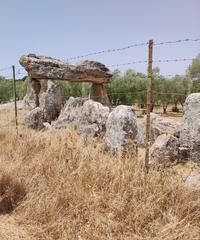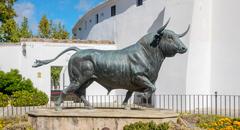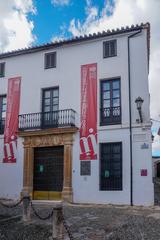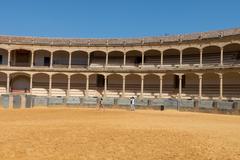Roman Theater of Acinipo: Visiting Hours, Tickets, and Travel Guide for Ronda’s Ancient Gem
Date: 14/06/2025
Introduction
Perched atop a windswept plateau north of modern Ronda, the Roman Theater of Acinipo—often called Ronda la Vieja or “Old Ronda”—is one of Andalusia’s most evocative archaeological sites. Dating back to the first century AD, Acinipo was once a thriving Roman city and today offers visitors a compelling combination of ancient ruins, sweeping landscapes, and historical intrigue. This guide provides comprehensive information on Acinipo’s history, practical visitor details, and travel tips to help you make the most of your journey into Spain’s Roman past (Krista the Explorer; Ancient Theatre Archive; Andalucia.com).
Table of Contents
- History and Origins
- Architectural Features of the Roman Theater
- Other Archaeological Remains
- Decline and Rediscovery
- Visiting Information (Hours, Tickets, Accessibility)
- Practical Tips for Visitors
- Nearby Ronda Attractions
- Special Events and Cultural Performances
- Frequently Asked Questions (FAQ)
- Summary and Final Tips
- References
History and Origins
Acinipo’s roots stretch back to the Bronze Age, with evidence of settlements as early as the 9th century BC (Krista the Explorer). The city gained prominence after the Roman conquest of southern Iberia in 206 BC, evolving into a strategic urban center along vital trade routes. By the first century AD, Acinipo supported around 5,000 inhabitants, minted its own coins (often depicting grape bunches as a testament to the region’s wine production), and reflected Roman urban planning with public buildings, baths, and a forum (Andalucia.com).
Architectural Features of the Roman Theater
The Roman Theater of Acinipo is the site’s architectural centerpiece and one of the best-preserved Roman theaters in Spain. Constructed between circa 65 AD and 200 AD, the theater is carved directly into a limestone hillside at about 1,000 meters elevation (Ancient Theatre Archive).
Key Features:
- Cavea (Seating): Designed in three sections (ima, media, summa), the cavea accommodated between 2,000 and 3,400 spectators. Its semicircular rows and wedge-shaped sectors provided excellent acoustics and visibility.
- Orchestra: The semi-circular area in front of the stage, paved in local stone, was used for performances and ceremonies.
- Stage (Pulpitum) and Scaenae Frons: The stage platform stretches nearly 30 meters, and remnants of the two-story stage building reveal columns, niches, and advanced stage machinery (including mast holes for curtains).
- Access and Circulation: Vomitoria (entrances) and stairways ensured efficient movement of audiences.
- Materials: Built almost entirely from local limestone, the theater harmonizes with its environment and demonstrates Roman engineering expertise (Travel Choreography).
Over the centuries, the theater was repurposed, notably as a Moorish watchtower, taking advantage of its strategic position (Ancient Theatre Archive).
Other Archaeological Remains
Beyond the theater, Acinipo’s archaeological landscape includes:
- Roman Baths: Remains of a bathhouse with caldarium, tepidarium, and underfloor heating indicate a focus on public hygiene and social life (Krista the Explorer).
- Residential Structures (Domus): Foundations of two-level houses signal the presence of affluent residents.
- Forum and Mosaic Fragments: Public spaces and mosaics offer further glimpses into daily life.
Many artifacts uncovered at Acinipo are displayed at the Municipal Museum of Ronda (Andalucia.com).
Decline and Rediscovery
Acinipo’s decline began in the 3rd century AD due to regional instability, with most inhabitants migrating to nearby Arunda (modern Ronda), favored for its defensible cliffs. By the 5th century, the city was largely abandoned. The site was rediscovered and systematically excavated during the 20th century, revealing its full archaeological significance (Andalucia.com; Our World for You).
Visiting Information
Opening Hours
- Standard Hours: Tuesday to Sunday, 10:00–14:00
- Closed: Mondays and selected public holidays
- Seasonal Variations: Summer visits may extend hours; always confirm via official tourism sources.
Tickets and Admission
- Admission: Free or a nominal fee (typically under €2)
- Purchase: Onsite; guided tours require separate booking (Ronda Today)
Accessibility
- Terrain: Uneven, rocky, and open-air; limited shade and partial accessibility for those with mobility challenges
- Facilities: Basic restrooms near entrance (not always open); minimal signage, mostly in Spanish
How to Get There
- By Car: 30–40 minutes north of Ronda via A-374; follow signs to Acinipo
- Parking: Available near the entrance
- Public Transport: Limited; car rental or guided tour recommended (Voyage Tips)
Practical Tips for Visitors
- Footwear: Wear sturdy walking shoes suitable for rough terrain.
- Sun Protection: Bring a hat, sunscreen, and ample water, especially in summer.
- Clothing: Dress in layers—temperatures can be cool and windy at elevation.
- Food: No on-site refreshments; pack snacks and water.
- Photography: The site’s elevated position offers stunning panoramic views, especially in early morning or late afternoon light (Zigzag On Earth).
- Guided Tours: Book through Ronda-based agencies for an enriched experience (Ronda Tours).
Nearby Ronda Attractions
Combine your visit to Acinipo with other Ronda highlights:
- Puente Nuevo Bridge: Ronda’s iconic 18th-century bridge spanning a dramatic gorge
- Plaza de Toros: One of Spain’s oldest bullrings
- Arab Baths: Well-preserved Moorish hammam
- Old Town: Whitewashed streets and historic churches (Ronda Today)
Special Events and Cultural Performances
Occasionally, the theater hosts classical performances and festivals, reviving its ancient role as a gathering place for the arts. Details are typically announced via the local tourism office or event organizers (Ancient Theatre Archive).
Frequently Asked Questions (FAQ)
Q: What are Acinipo’s visiting hours?
A: Tuesday to Sunday, 10:00–14:00. Closed Mondays and some holidays. Confirm before your visit.
Q: Is there an entrance fee?
A: Admission is free or under €2.
Q: Are guided tours available?
A: Yes, primarily via local agencies or as part of regional historical tours.
Q: Is the site accessible for people with disabilities?
A: Terrain is uneven and rocky; accessibility is limited.
Q: What should I bring?
A: Sturdy shoes, sun protection, water, snacks, and layered clothing.
Q: Are there restrooms or facilities?
A: Basic restrooms near the entrance; no shops or cafes.
Q: Can I take photos?
A: Absolutely! The site is highly photogenic.
Summary and Final Tips
The Roman Theater of Acinipo is a captivating destination that offers a rare glimpse into the Romanization of southern Spain and the architectural ingenuity of ancient Rome. From its origins as a bustling city to its eventual decline and rediscovery, Acinipo stands as a testament to Andalusia’s rich historical tapestry. Practical details such as free or low-cost admission, seasonal opening hours, and travel recommendations ensure an accessible and rewarding visitor experience.
Whether you are a history enthusiast, a traveler seeking inspiration, or a photographer in search of stunning landscapes, Acinipo and its surrounding sites are well worth exploring. Enhance your journey by also visiting Ronda’s historic center, the dramatic Puente Nuevo, and the evocative Arab Baths.
For the latest updates, downloadable guides, and interactive experiences, consider the Audiala app and consult local tourism resources before your visit.
References and Further Reading
- Krista the Explorer
- Ancient Theatre Archive
- Andalucia.com
- Ronda Today
- Spain.info
- Our World for You
- Travel Choreography
- Voyage Tips
- Zigzag On Earth
- Ronda Tours
- Our Spanish Life
- adventurebackpack.com



